Cabbage white (cabbage) - a pest of cruciferous. Caterpillars feed. Especially strongly damages white and cauliflower, as well as rutabagas, turnips, radishes, radishes, turnips, horseradish, rapeseed, mustard. Reproduction is bisexual. The development is complete. Diapausing pupae hibernate. Up to five generations develop during the growing season.
(cabbage, radish, turnip and other cruciferous crops)
Cabbage white or cabbage — widespread and dangerous cabbage pest and other cruciferous crops.
Butterfly in a wingspan of 50-60 mm, the wings are white, on the front wings the upper corners are black, and on the hind wings there are blackish longitudinal strokes along the inner edge; the female, unlike the male, has two round spots on the upper side of the forewings.
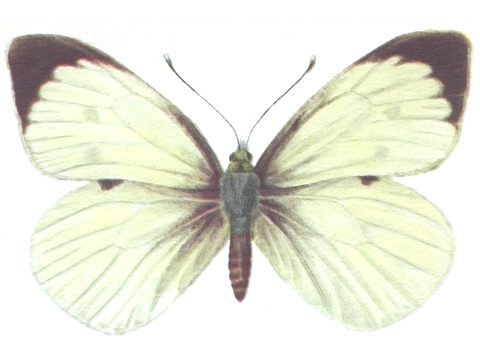 female cabbage white
female cabbage white
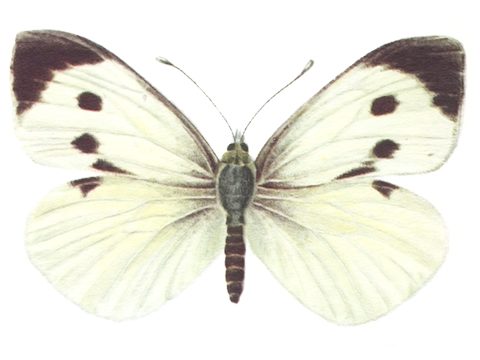 Male cabbage white
Male cabbage white
adult caterpillar reaches a length of 40-45 mm, the larva is gray-green above, yellow below, covered with bristles and hairs; on the surface of the body there is a pattern of black spots and dots grouped in transverse rows; three longitudinal yellow stripes run along the sides and back.
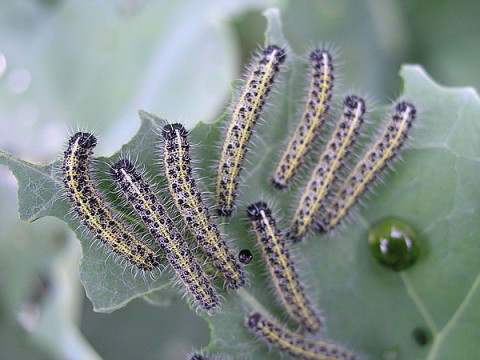 Caterpillars of the cabbage white
Caterpillars of the cabbage white
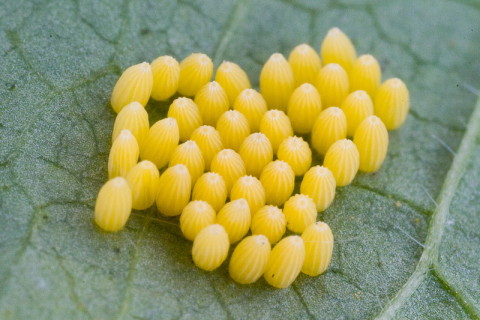 cabbage white eggs
cabbage white eggs
The pupa is angular in shape, greenish-yellow in color, with black dots on the back and sides.
cabbage white
is a common pest of cabbage. It is widespread in Russia (with the exception of the Far North). The cabbage plant is most harmful in the northwestern and western regions of Russia.
Cabbage whitefish overwinter in the pupal stage on tree trunks, shrubs, building walls, fences, etc.
Butterflies fly out in spring: in the southern regions - in April (and in Transcaucasia even at the end of March), in the middle lane - in May.
Butterflies fly during the day, feeding on the nectar of flowers of various plants, and they prefer cruciferous plants.
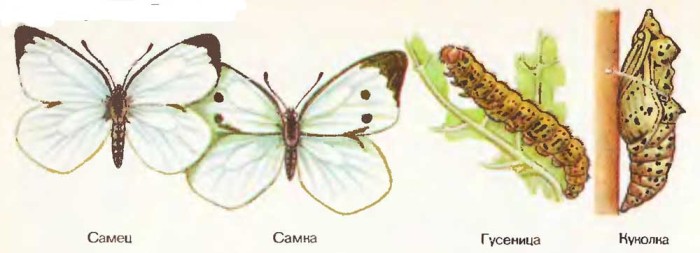 Cabbage white. Biological portrait of the pest
Cabbage white. Biological portrait of the pest
In large numbers, cabbage butterflies concentrate on wind-protected areas located near buildings, fences, tree plantations, and in small gardens; on large areas of cabbage planting, it usually populates the edges of the field more strongly.
Butterflies of the cabbage white soon after emergence lay their eggs mainly on the underside of the leaves of cabbage and other cultivated and weed cruciferous plants.
Females lay their eggs in groups of 15 to 200 in each heap.
After 6-13 days, yellowish caterpillars with a black head develop from the eggs. Young caterpillars are all together at first. They gnaw the flesh of the leaf from the underside, without touching the upper skin.
Later, the caterpillars spread throughout the plant and eat the leaves, mainly from the edges.
Adult caterpillars are more often on the upper side of the leaves and can severely damage them, often leaving only the coarse veins intact.
Caterpillars damage cabbage, rutabaga, radishes, turnips and other cruciferous plants, and can also feed on some plants from other families, namely mignonette, nasturtium, capers.
Depending on the temperature, development in the caterpillar stage lasts from 15 to 30 days, after which they turn into pupae. Pupation, as already mentioned, occurs on trees, fences, building walls, etc., and only rarely on cabbage leaves.
After 10-17 days, the pupae turn into a new generation of butterflies, which usually lay their eggs at the end of July and in August (middle lane).
The second generation of cabbage usually develops in large numbers if the fight against the first generation caterpillars is not carried out.
In the south, the cabbage white has 3-4 (Central Asia) and even 5 (Transcaucasia) generations.
Geographic distribution cabbage white
limited mainly by climatic conditions. Its advancement to the north, as well as to Siberia, is hindered by low winter temperatures, since at a temperature of -20 ° C, wintering pupae die in significant numbers. Therefore, after a cold winter, the number of cabbage usually decreases sharply.
The optimum temperature for the development of cabbage whites lies between +20 and +26°C. Very high temperature (over 35-38 °) inhibits the development or causes the death of the cabbage white .
Attention! You need to know how to deal with cabbage, because it not only violates the integrity of the fruit, but is also a carrier of fungal spores and bacteria.
Measures to combatwhitewash
Use in the fight against cabbage
natural remedies and methods of protection
It is practically impossible to protect yourself from butterflies that have arrived from neighbors.
But limiting their population is real.
- The cabbage white caterpillar is actively eaten by the ichneumons Apanteles glomeratus. Their cocoons are next to caterpillars and cabbage larvae. By their presence, the presence of a pest is judged. In a favorable climate, an insect can completely destroy the whitefish population. It is reborn thanks to the constant migration of butterflies from plantation to plantation.
- The fight against cabbage is carried out with the help of a wax moth. This is a bacterial culture. It causes disease first, then the death of the larvae.
- In mid-April, it is better to wash all fences, fences, walls near standing buildings with a stream of water, washing off the pupae remaining after the winter.
- Butterflies can be lured with hand-made baits. Yeast sweet syrup is being prepared. Small containers (disposable cups, boxes) with the drug are placed between cabbage bushes and other cruciferous plants. Trapped butterflies need to be thrown out periodically.
- Plants that repel cabbage butterflies are used: mint, lemon balm, marigolds, thyme, marigolds, valerian, sage. Take 40 ml of valerian and 3 liters of water.
- With small beds and planting cabbage, you can collect the eggs laid on the leaves. Catching butterflies and caterpillars by hand is practiced.
- The invasion of cabbage can be overcome with the fungus Entomophtora sphaerosperma. The peak of its growth falls precisely on the mass reproduction of the pest.
- Before the beginning of summer, seedling bushes are covered with agro-canvas or mosquito nets so that butterflies do not sit on the crop.
- Using herbal infusions is one way to get rid of cabbage whites. They are applied once every seven days.
- Mustard solution for irrigation is prepared from 10 liters of water and salt (2 tablespoons), mustard (2 tablespoons), ground black or red pepper (1 teaspoon).
- A coniferous concentrate of 200 g of cones (spruce or pine) and 2-2.5 liters of slightly warmed water helps. The composition is infused for 7 days. After that, it is filtered and placed in a cold place until use. Before spraying, the composition is diluted with water (1:10).
- Another way: wood ash (sifted) in the amount of 0.5 liters is infused in boiling water (bucket). The liquid fraction is drained. Liquid soap is added to it (2 tablespoons). Everything mixes well.
- Grass growing near each dacha (wormwood, yarrow, burdock) is poured with boiling water in an amount of 1:3. Insist 3-4 days. Strain and process.
Attention! Unfavorable weather conditions for the development of cabbage also affect the population increase: low air humidity (no more than 60%) and, conversely, high temperature (+26°C and more). At temperatures of -20 ° C, the pest also dies. Any spraying should be carried out in dry, calm weather, preferably in the evening.
Use of chemical protective equipment
The harm from cabbage butterflies to agriculture is huge.
It can be radically combated only with the help of chemicals.
The disadvantage of the method is that beneficial inhabitants of the garden also suffer from poisons: bees, birds, etc.
With a massive defeat of cabbage, when it comes to large areas, you need to apply:
- Lepidocide,
- Fitoverm,
- Karbofos,
- kinmiks,
- Decis,
- Bitoxibacillin,
- Actellik.
Spraying begins at an early stage, when the leaves are just coming out. This avoids the absorption of insecticides by plants. The treatment must be repeated at the first appearance of the larvae to destroy them.
Biological product Fitoverm on the contrary, it can be used during the entire growing season. Spraying ends just before harvest. From the same series of biological agents Lepidocide, Bitoxibacillin. They are preferred when processing cruciferous beds on small plots of land.
A good effect is obtained by spraying against caterpillars with Iskra-M from caterpillars:
5 ml (1 ampoule) per 5 liters of water at the rate of 1 liter per 10 sq.m.
You can also use Iskra DE: 1 tablet per 10 liters of water.
A lot of cabbage butterflies - a familiar picture in the gardens. This phenomenon occurs almost every year. It is impossible to overcome the pest, but everyone can limit its spread. To do this, you need to competently carry out prevention, determine the need to use insecticides everywhere, carry out treatment with biological products. Then a good harvest of cabbage is guaranteed.
One of the four "horsemen of the Apocalypse" of the garden, the other three: bad weather and phyto-diseases. And this time the evil is hidden under the guise of a beautiful white cabbage butterfly, from which children and adults who are not connected with dacha affairs are delighted. In fairness, it is worth noting that it is not the adult that harms the vegetables, but its caterpillars, but this does not significantly change the state of affairs, and if you do not intend to share your meal with these eaters, you should get to know the enemy a little and learn how to deal with him.
Description of the pest
It is perfectly familiar to the vast majority of the adult population of the planet and hardly needs an additional description. Delving into biology, we can add that a pretty pest belongs to the family of whites and does not always live next to a person, but also in meadows, on the edges of forests, along roads.
The adult mask of an insect or imago (butterfly) is absolutely harmless for agriculture and feeds, as befits beautiful creatures, on the nectar of flowers, most often dandelions, alfalfa or calico. 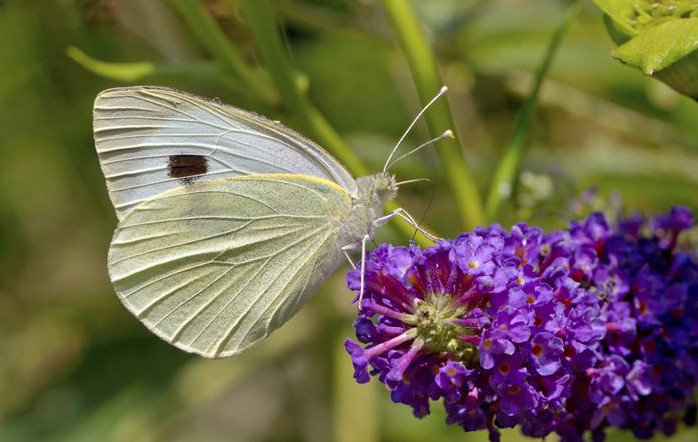 What cannot be said about its intermediate form of development - the caterpillar. It is the caterpillar that feeds on juicy pulp, leaving huge holes in the sheets at the place of its meal.
What cannot be said about its intermediate form of development - the caterpillar. It is the caterpillar that feeds on juicy pulp, leaving huge holes in the sheets at the place of its meal.
The cabbage butterfly caterpillar is relatively small, as you can see in the photo below - quite beautiful colors: a greenish-blue back and a yellow belly. Her body is covered with black hairs, and a row of black dots stretches along the body on both sides. Such caterpillars prefer to eat at the bottom of the plant, since closer to the humidity is higher and the air temperature is lower. 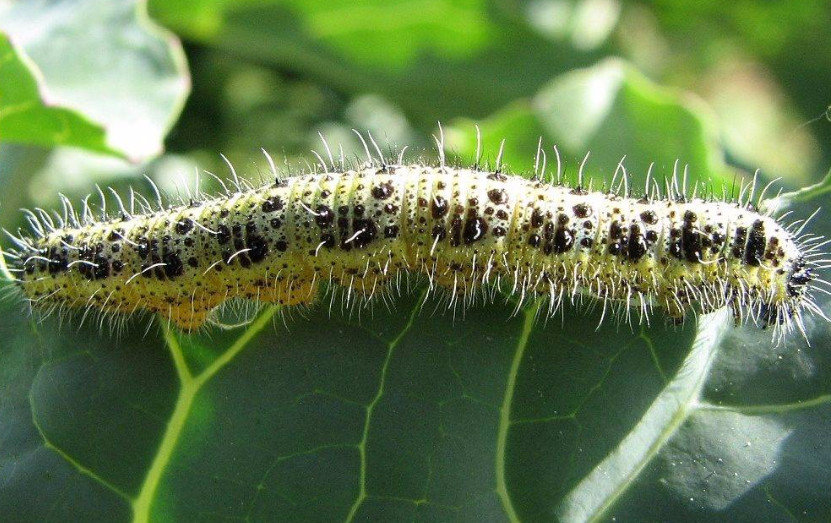
Important! The fact is little known, but caterpillars of whitefish are quite poisonous. For humans, their toxin is not dangerous and causes allergies or skin irritation, but cases of death that accidentally swallowed these insects have been fixed.
Life cycle features
The duration of the life cycle of the whitefish depends on temperature conditions: the more favorable they are, the faster the insect develops, if the conditions are unfavorable, then ontogenesis can be delayed for a decent period. For example, at an air temperature below 20°C, the process of turning a caterpillar into an adult can take three times (from 13 to 38 days)!  On average, at a stable temperature of 20-26°C, the development from egg to adult and natural death of the insect takes 30-75 days, during which the cabbage butterfly goes through 3 transformations and 4 molts.
On average, at a stable temperature of 20-26°C, the development from egg to adult and natural death of the insect takes 30-75 days, during which the cabbage butterfly goes through 3 transformations and 4 molts.
- Egg stage. After mating, an adult female lays 200 to 300 fertilized eggs on the underside of a head of cabbage in order to protect them from drying out and possible natural enemies. The eggs are lemon yellow; elongated, oval in shape and about 1.25 mm in size. Depending on the air temperature, incubation takes from 5 to 16 days.
- Caterpillar stage. Young, before the first molt, caterpillars differ from their subsequent incarnations: they reach a length of only about 1.7 mm., have light green color, which serves as an excellent disguise and makes them invisible on the heads of cabbage. Also, until the second molt, insects stay together, feed in one place and practically do not move from their place.
- 1, 2 molts. At this time, caterpillars actively increase in size, but in other respects remain morphologically unchanged. During this period, the insects do not yet cause tangible harm to the cabbage, being content with scraping off the upper part of the pulp at the base of the leaf.
- 3.4 molt. After the third molt, the caterpillar significantly increases in size, acquires a green-yellow color and becomes able to move long distances, destroying ever larger volumes. At this stage, the damage caused becomes more noticeable: through holes appear on the sheets, the vegetable is contaminated with pest excrement. Sometimes, with a strong defeat, only gnawed veins remain from the outer leaves of cabbage.
- Pupa. After the last, fourth molt, the caterpillar reaches its maximum size (50-60 mm.) And after staying in this state for 7-10 days, it begins to pupate. In May/June of the following year, adults emerge from the pupae. The period of holometabolism (the state of the chrysalis) in the whitefish lasts 9-30 days. In warm regions, from 2 to 4 generations of butterflies can be hatched in one season. This is what a cabbage chrysalis looks like:
Did you know? Some butterflies don't feed at all - they just don't have a mouth! And these insects live due to the energy accumulated in the caterpillar stage.
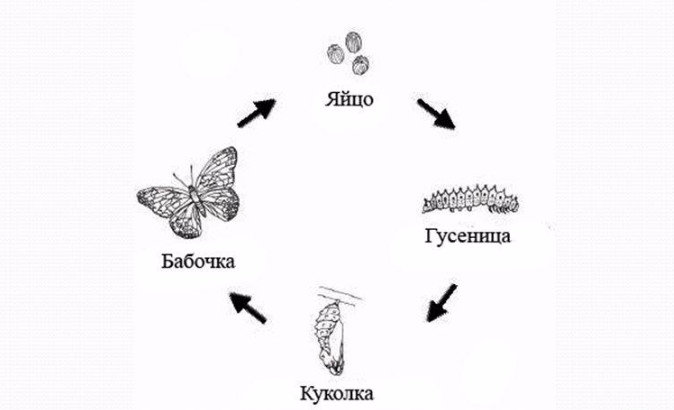
How to detect a pest and what is its danger?
It is possible to identify a pest in the early stages of ontogenesis only with a thorough examination of the basal part of the cabbage heads. You can start inspecting seedlings already in the middle. At this time, you need to focus on the detection and destruction of clutches.
This is what the laying of the whitefish looks like. Closer to the middle of June, the enemy will look like this:  You can also detect caterpillars during the inspection, because at this stage of their development they still do not cause significant harm to the plant and it looks healthy. The most dangerous for the future crop are caterpillars after 3-4 molts. These pests are extremely voracious and the affected vegetable is very visible, and the presence of insects is beyond doubt. Head affected by whites:
You can also detect caterpillars during the inspection, because at this stage of their development they still do not cause significant harm to the plant and it looks healthy. The most dangerous for the future crop are caterpillars after 3-4 molts. These pests are extremely voracious and the affected vegetable is very visible, and the presence of insects is beyond doubt. Head affected by whites: 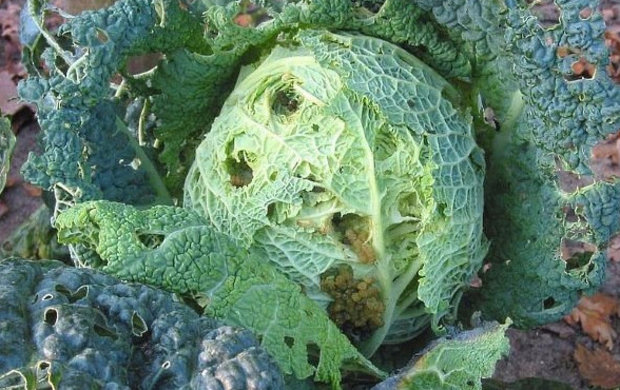 Since the caterpillars are most active at this time, you can easily see them crawling freely throughout the plant:
Since the caterpillars are most active at this time, you can easily see them crawling freely throughout the plant:  Also, one of the harbingers or early signs of the presence of cabbage can be adult individuals of these insects flying over crops.
Also, one of the harbingers or early signs of the presence of cabbage can be adult individuals of these insects flying over crops.
Damage
With extensive lesions, white caterpillars can significantly reduce the quality of the crop, or even make it completely unsuitable for consumption.
The damage caused by their mandibles results in the loss of moisture accumulated by the vegetable. Given the peculiarities of cabbage vegetation, for which an air temperature of about 20 ° C is optimal, summer heat and increased, due to damage, evaporation of moisture, can cause growth to stop, loss of its qualities, or even death of the plant. Symptoms of the described situation: yellowing, loss of elasticity, and then complete drying of the sheets. 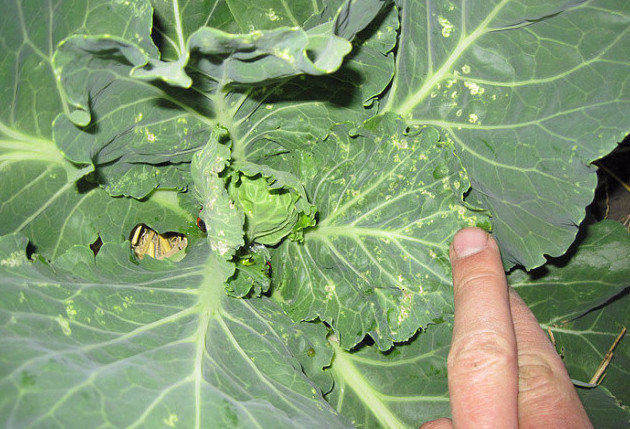 But moisture loss is not the only danger. Damage opens the way inward to a variety of pathogenic bacteria and fungi, which will certainly finish the work begun by pests. "Wounded" vegetables become defenseless against such as gray mold, punctate bacteriosis / necrosis and downy mildew (peronosporiosis).
But moisture loss is not the only danger. Damage opens the way inward to a variety of pathogenic bacteria and fungi, which will certainly finish the work begun by pests. "Wounded" vegetables become defenseless against such as gray mold, punctate bacteriosis / necrosis and downy mildew (peronosporiosis).
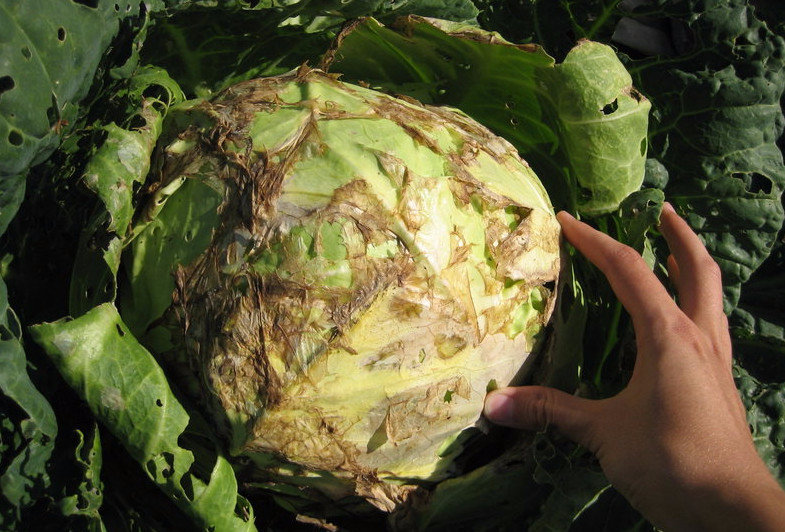
How to fight?
The fight against garden and garden pests is a moment that causes internal dissonance in any gardener. After all, on the one hand, most of us in our own garden are attracted precisely by the opportunity to get environmentally friendly, 100% useful product. And when it becomes necessary to use poisons, the “worm” of doubt begins to undermine the pathos healthy eating"pure" products.
Fortunately, many methods of struggle have been developed, both in laboratories and by the forces of the gardeners themselves, to destroy cabbage caterpillars. It is advisable to consider the most effective and safe for human health of them.
Preparations
The trust of gardeners was able to win such insecticides as Fitoverm, Aktellik and Lepidocid.
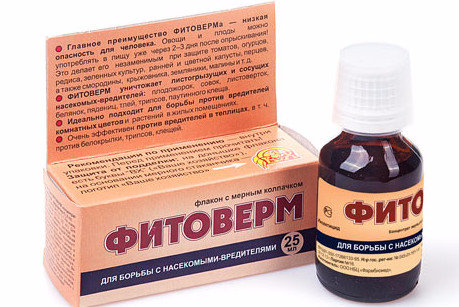
Important! Control methods must be selected in accordance with the expected stage of development of insects. For example, it makes no sense to spray crops if the pests have not yet hatched from the eggs or have already pupated.
Biological methods and folk remedies
Biological methods include the use of organic and entomophages. And if everything is more or less clear with biological insecticides, then entomophages are a new concept in domestic gardening.
Entomophages are insects, natural enemies of garden pests. And here grandmother's stories are remembered about how useful a ladybug is, because she eats. Indeed, such a method of struggle seems ideal, because it will allow you to avoid the cost of poisons, and morally it is much easier to put a “clean” product on a plate. The catch is how to show these cute little animals hot places with an abundance of caterpillars? There is a way!
Speaking about the natural enemies of the cabbage, we can name the Pimpla rider (Pimpla Fabricius). 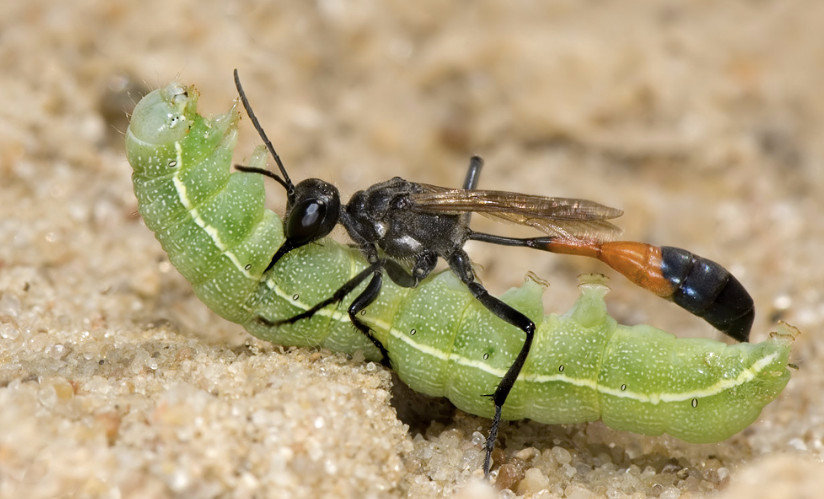 Studies using these riders, conducted in the Kyiv region in 1944, showed the almost complete destruction of the whites (95-98%). Adults are attracted to nectar-bearing plants, so it is advisable to plant dill and other flowering crops next to the cabbage. Wormwood, mint and tansy will scare away butterflies.
Studies using these riders, conducted in the Kyiv region in 1944, showed the almost complete destruction of the whites (95-98%). Adults are attracted to nectar-bearing plants, so it is advisable to plant dill and other flowering crops next to the cabbage. Wormwood, mint and tansy will scare away butterflies.
Folk methods are also popular.
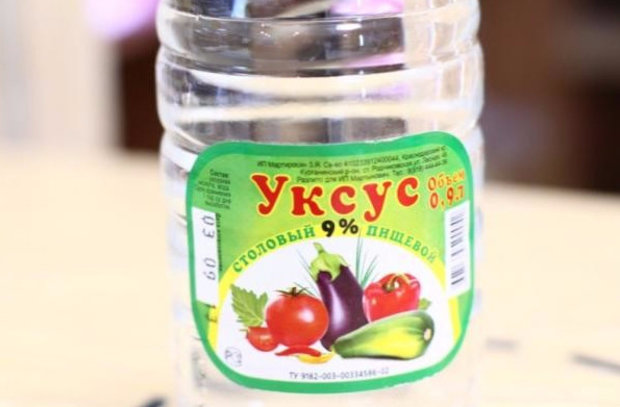
Did you know? The sense of territory is not unique to animals. A butterfly will not settle in a place where another has previously settled. Seeing this pattern, some use an eggshell, planted on a stick, which butterflies perceive as their own kind.
Prevention
Going deeper, you can be convinced of the vast experience and activities of gardeners who publish dozens of preventive methods designed to avoid damage by whitefish. Based on the fact that not everyone has special structures and equipment to implement complex preventive schemes, there are several accessible, but no less effective (and even mandatory) ones.
- Soil loosening. It is important to dig and loosen the soil in the fall after harvesting and before planting a new one.
- Burning from the fall of landing sites. The ash fertilizes the soil, destroys the seeds and pupae of the cabbage, which may remain somewhere in the planting area.
- Prevent cruciferous weeds from growing, which will become an additional breeding ground for pests.
- Differentiation of landing sites. Everyone knows the rule that it is impossible to allocate a certain piece of land for one crop for a long period. This leads to the accumulation of species-specific diseases, bacteria and pests.
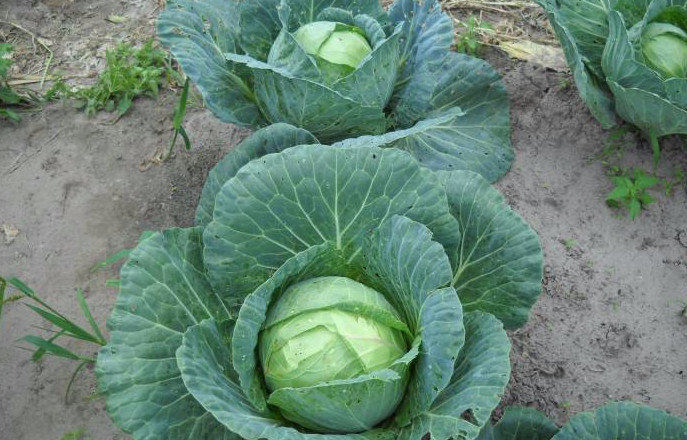 Proper gardening and sound pest control practices will do most of the work involved in growing vegetables for you. Act wisely and luck is guaranteed to you!
Proper gardening and sound pest control practices will do most of the work involved in growing vegetables for you. Act wisely and luck is guaranteed to you! Was this article helpful?
Not really
For people who are little familiar with agriculture, the cabbage butterfly causes joy and is associated with the arrival of warm summer days, but the appearance of this insect does not bode well for vegetable growers. A beautiful creature is a dangerous pest, its voracious offspring can cause significant damage to many garden crops.
This insect is a representative of the largest family of whites, it causes gigantic harm mainly to cabbage plantations and cruciferous vegetables, which gave reason to call it cabbage. From Eastern Europe to Sakhalin, a small cabbage butterfly is found, so its description is known to most professional vegetable growers and amateurs. Her wings are white with characteristic black spots, reaching 6.3 cm in span. The butterfly lives in vegetable gardens, on roadsides, in gardens, park areas, on forest edges and numerous forest belts.
Already in the first days of May, the cabbage butterfly produces the first caterpillars, in just a season it gives up to 5 generations. In the European climate, butterflies emerge from pupae in May and early August. Its caterpillars are greenish-yellow in color, covered with short dark hairs, and have yellow stripes on their backs. They go through the main stages of development in a few weeks. In the pupal stage, insects hide on the fence, in the bark of plants, among the stones.
Having begun to plant vegetables of the cruciferous family on a large scale, people created huge fabulous gardens in their fields with food for cabbage butterflies, which provoked the reproduction and spread of these insects on a global scale. They feel worse in hot climates with temperatures above 26°C and low air humidity, in regions with prolonged severe frosts below 20°C.
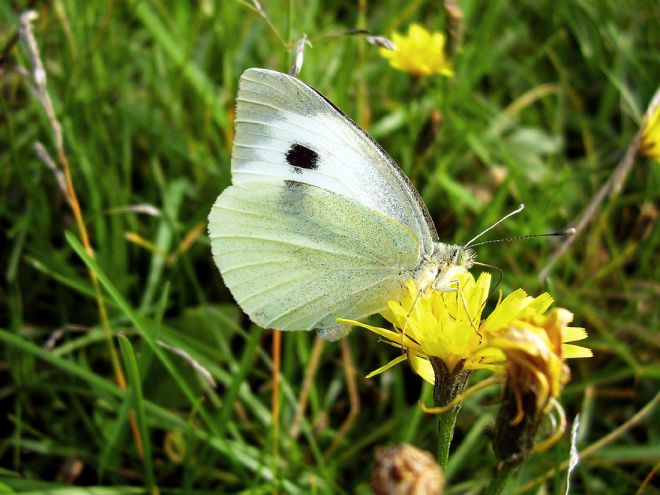
Butterfly cabbage - harm
It is necessary to distinguish between what cabbage butterflies and their numerous offspring eat. Caterpillars eat all kinds of cabbage, horseradish, swede and radish, turnips with turnips, field plants cruciferous family. The butterfly itself is harmless and pollinates flowers; it does not pose an immediate danger to garden crops. It is desirable to carry out preventive work on the destruction of cabbage at all stages of its development.
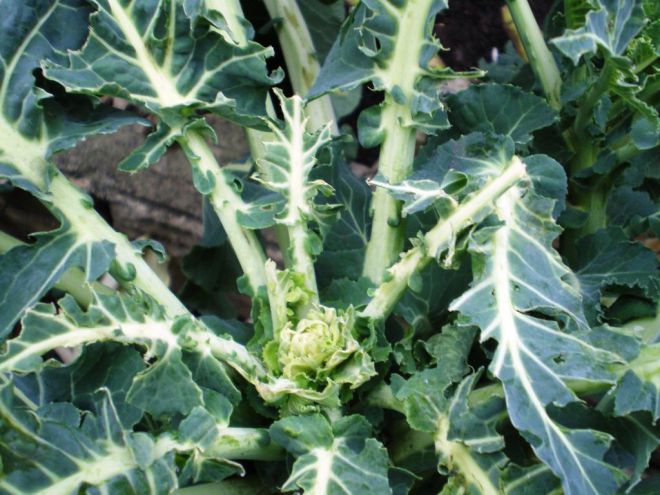
Our insect is a highly specialized creature that loves exclusively cabbage crops. It lays eggs on the underside of the leaf plate, hiding them from birds and people. Caterpillars are green in color, merging well with cabbage leaves. Gradually, they devour the leaves from the edges to the coarse textured skeletal veins. In large numbers, pests completely eat the entire head of the plant. In the question of how to protect cabbage from cabbage butterflies, you can use both folk and chemical methods.

Our heroine can be found both in the garden and on various trees or bushes. Often cabbage butterflies sit on raspberries, what should a gardener who is worried about his plantings do in this case? You can not be afraid, this insect does not threaten raspberries with its hard leaves. Sometimes a hawthorn butterfly is mistaken for it, which comes from a common family of whites, has similar sizes and coloring of wings. This pest seriously infects fruit and berry crops located next to raspberries.
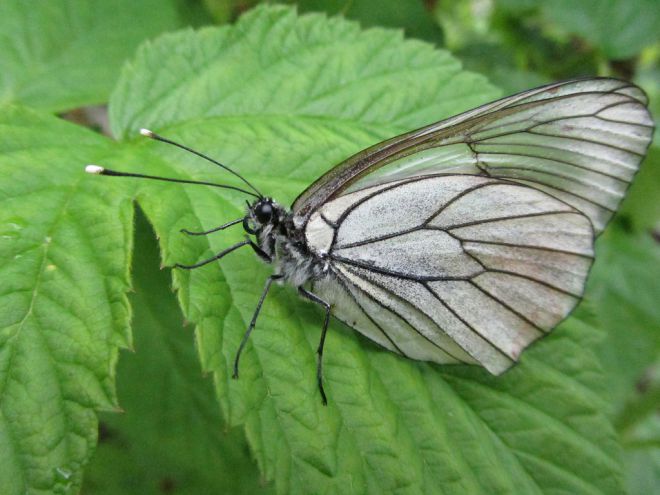
Why are there a lot of cabbage butterflies in the garden?
Novice gardeners are often confused about what cabbage butterflies eat, considering them to be pests of tomatoes, berry and fruit trees. Our heroes are attracted exclusively by cabbage beds and plants from the cruciferous family. They often fly not in flocks, but alone, sometimes overcoming over 30 km per hour. The first eggs are laid on weeds, but the remaining generations are accurately attached to cultivated plants.
Fields with plantations of cruciferous vegetables attract them with special substances with a bitter taste - sinigrin and sinalbin. These compounds are also present in some herbs - mignonette, nasturtium, plants of the caper family. The smell from these chemical compounds is felt by a butterfly in a fraction of a gram, instantly determining which leaf to lay an egg on. The more often you plant monocultures in the same garden without using crop rotation, the greater the likelihood of a strong infection of the site with this pest.
People have been fighting whites for centuries, many different ways have already been invented to get rid of cabbage, from exposing insects with potent drugs to scaring away butterflies folk remedies. With a small infection of the beds with caterpillars, one can limit oneself to preventive measures - safe infusions and decoctions that are unable to critically poison the human body.
Prophylactic agents against cabbage butterflies:
- Constantly from the beginning of the garden season, destroy weeds in the garden, butterflies lay their eggs on them in early spring.
- Make a daily inspection of the cabbage from the underside of the leaf, collecting white eggs.
- Autumn digging of the garden helps to reduce the cabbage population.
- In the autumn, inspect the bark of fruit trees, destroying pupae.
- It is advisable to plant cabbage in the early stages before the mass departure of butterflies.
- Do not place cabbage next to horseradish, turnips, radishes, field mustard.
- If the bed is small, then it can be covered with a thin plastic mesh that conducts the sun's rays well, but protects the plant leaves from contact with the insect.
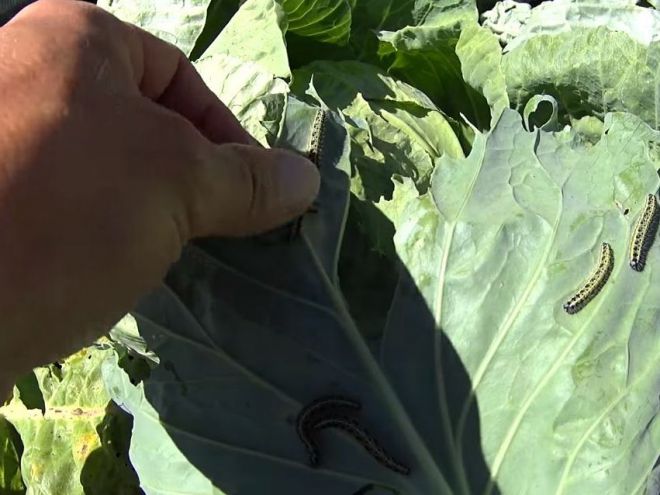
Preventive measures alone cannot cope with the pest, if there are a lot of other vegetable gardens around your site, then there is always the possibility of new generations of butterflies migrating to your garden in the summer. In the matter of how to deal with cabbage, preparations based on infusions from plants help well. They do not act instantly, have a shorter protective period compared to chemical preparations, but are practically harmless to humans. When processing cabbage, liquid soap should always be added to the water!
Folk remedies for cabbage butterflies:
- In 3 liters of water, a bottle of valerian pharmacy infusion is diluted, spraying the garden is done immediately after preparing the solution.
- We hang cups or eggshells in the garden.
- Coniferous infusion - cones, needles, spruce or pine branches are used. It is necessary to insist up to 200 g of the collected material in 2 liters of boiling water. The needles are decanted after a week, the concentrate is applied with water in a ratio of 1:10.
- Helps from whites infusion of 600 g of potato tops, aged 48 hours in a bucket of warm water.
- Spraying with infusion of delphinium leaves (1 kg of dry leaf per bucket of water).
- Treat the heads of cabbage with a solution of ammonia - 50 g of the drug per 10 liters of water.
- Salt solution is used against whitefish - 2 tablespoons of salt per bucket of water.
- You can use tomato tops to make a decoction. Up to 1 kg of leaves and shoots pour 3 kg of boiling water and cook for half an hour. The resulting liquid is cooled and used to process cabbage beds.
- Soap-ash solution - a pound of sifted ash is poured into a bucket of boiling water, insisted, drained, separating the clear liquid from the sediment.
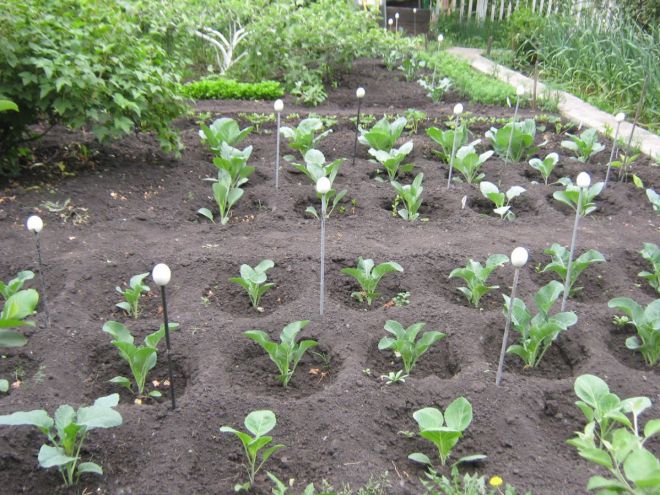
How to poison cabbage?
If the fight against cabbage with folk remedies does not bring results, then with a large distribution of the whitefish and its caterpillars, you need to move on to
Not only people like to eat cabbage. Many pests also do not pass by its succulent leaves. , white butterflies, caterpillars, cabbage leaf beetles, whiteflies, slugs, snails - this is an incomplete list of those who want to taste juicy leaves and stalk. Most experienced gardeners already know how to get rid of caterpillars on cabbage. For beginners, this topic is quite burning and eternal.
Habitats of leaf-eating insects
Among cabbage lovers, several butterflies appear in our gardens:
- cabbage white or cabbage;
- turnip;
Cabbage white or cabbage- this butterfly with white wings, at the ends of which there is a black border and black dots. In May, she lays her eggs on the underside of cabbage leaves. The caterpillar of the cabbage butterfly is gray-green with yellow stripes and black spots.
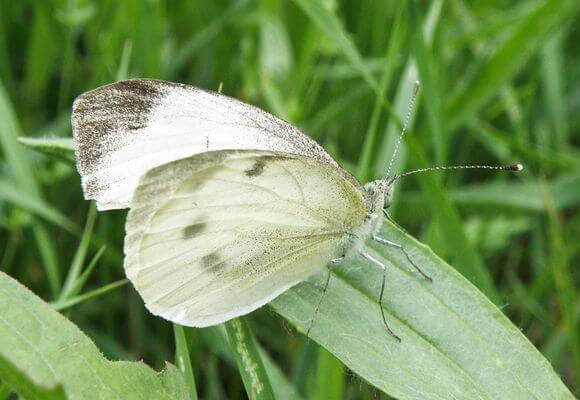
They usually live on the upper side of the leaves. On one leaf, cabbage lays up to hundreds of eggs. This is quite enough to eat all the leaves of the cabbage. Caterpillars prefer tender young leaves; they not only damage plants, but also significantly delay their development.
If you do not destroy the leafworms in time, then the heads of cabbage will grow small and corroded.
Repnitsy- a diurnal butterfly, very similar to a whitefish, but three times smaller in size. Eggs are laid not in clutches, but singly. Caterpillars are velvety green with a yellow stripe. Cabbage is eaten not only by the leaves, but also by the head of cabbage from above.
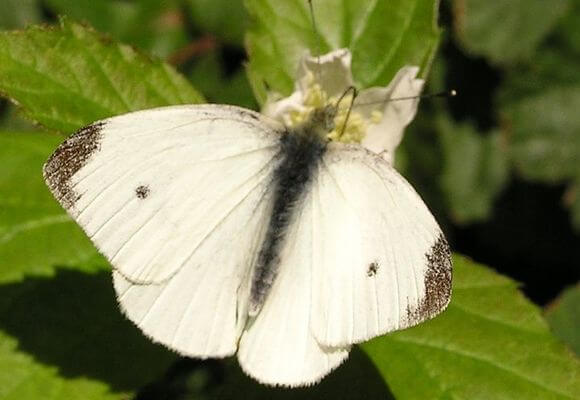
cabbage scoop- a small butterfly the size of a moth, with a nondescript gray color. From her masonry, small green caterpillars appear, living inside the head of cabbage. These butterflies are nocturnal, hiding in the ground or in leaves during the day. Their presence becomes noticeable by the holes in the cabbage, which are gnawed by their caterpillars. Pests live on the underside of the leaves at night and sleep in the stalk during the day.
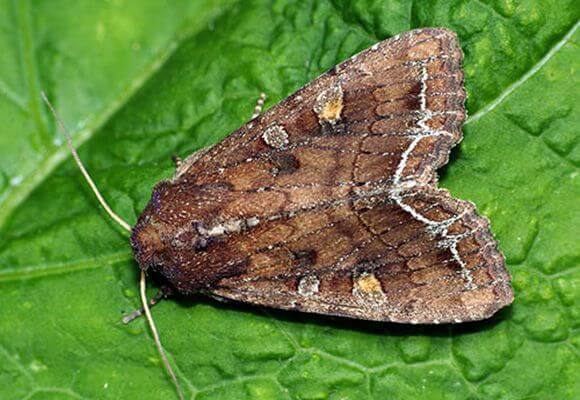
cabbage moth - moth gray-brown color with a light pattern, 8 mm in size. Overwinters in weeds. It flies badly and close. Appears in April-July. It feeds on plant sap. Lays eggs on the underside of the leaf. Moth caterpillars are very small, green.
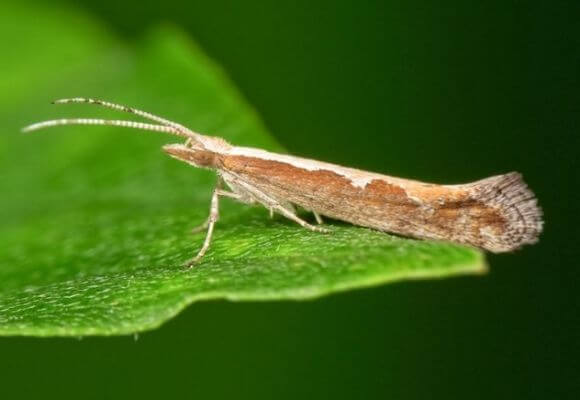
The time of existence of caterpillars before their pupation is only 15-30 days. After which they turn into butterflies, which again lay eggs and hatch the next generation of caterpillars, they again continue to eat cabbage. Over the summer, these transformations are repeated three times and there is no longer any hope for a harvest.
Folk ways of fighting
Gardeners prefer to start the destruction of harmful insects with folk remedies that are harmless to humans. These methods are noticed in observations of wildlife:
- attracting wasps and ants that feed their larvae with caterpillars. You can draw their attention to pests by watering the beds with plants with a sweet aqueous solution;
- infusion of ash with the addition of laundry soap for better hiding power. It is enough to add two glasses of ash and a few tablespoons of soap to the bucket, insist the solution for a day and moisten the cabbage leaves;
- eggshells laid out on cabbage leaves can deceive white butterflies. The cabbage lady takes the white shell for her more successful rivals and does not encroach on the already occupied territory;
- sprinkle a head of cabbage with a mixture of soda and flour, the cabbage white and other butterflies and caterpillars will die;
- an infusion of odorous plants with a pungent smell and taste will scare away butterflies from watered beds. In this case, an infusion of tomato stalks, potatoes, garlic, onion peels can help. The infusion should be saturated. To do this, take 2-3 kg of tomato tops, 10 heads of garlic or a jar of onion scales. The crushed raw materials are poured with boiled water, left under the lid during the night or day. After that, soap is added to the infusion for better adhesion and the entire affected area is thoroughly moistened;
- a solution of vinegar will very effectively help in the fight against insects on seedlings or cabbage. To do this, in a bucket of water, it is enough to dilute two glasses of 9% vinegar or 2 tbsp. l. vinegar essence and water the beds from the watering can;
- a solution of ammonia can be made by diluting 50 grams of alcohol in a bucket of water;
- saline solution is also not tolerated by leafworms. Dissolve 2 tbsp in a bucket of water. l. salt and pour the product on the leaves.
We must not forget to especially carefully moisten the undersides of the leaves with a solution or mixture. Processing is carried out in dry and calm time.
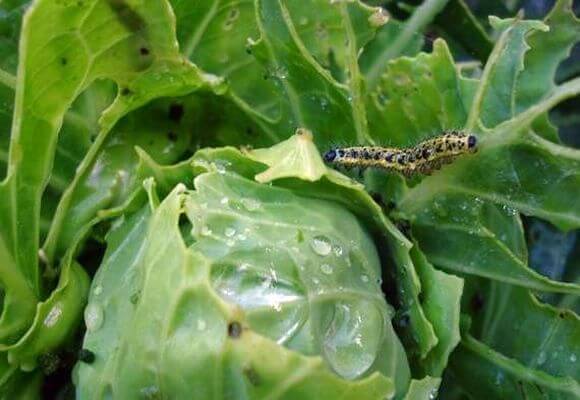
Many gardeners simply collect the insects in jars and destroy the eggs on the cabbage leaves, getting rid of uninvited visitors through physical destruction, which is also very effective in controlling caterpillars on cabbage.
Important! Caterpillars have delicate outer integuments, with careful care it is often possible to destroy them in one treatment.
Microbiological control methods
New ways to deal with garden leaf-eating pests have appeared not so long ago. With the development of organic farming, microbiological preparations have appeared on the market to deal exclusively with insects. They are not dangerous for humans, plants, do not affect birds and animals.
Their mode of action is based on the development of a particular type of microbe that infects insects. They get sick and die. With the disappearance of pests, microbes or fungi also disappear.
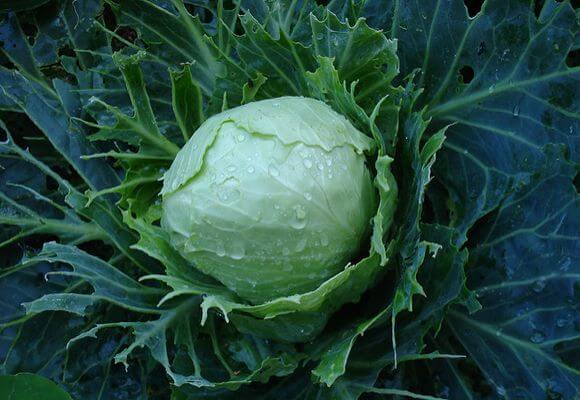
In addition to microbiological preparations, mushroom preparations, which act similarly to microbiological agents, help plants in getting rid of leafworms.
Important! Microbiological and fungal preparations affect only insects. The destruction of pests in this case occurs naturally in an environmentally friendly way.
Entobacterin is a gray powder. Getting into the body of caterpillars during feeding, leads to their death. 50 grams of powder is diluted in 10 liters of water and cabbage is sprayed.
The effect of the drug depends on the temperature. During its application, it should be in the range of 18-30 degrees. At low temperatures, the drug stops working, as microorganisms simply do not multiply under these conditions. Spend at least two treatments of plants in one week.
The use of a microbiological agent is stopped a week before harvesting.
Exists whole line products created with the use of various types of bacteria:
- Lepidocide - used to destroy caterpillars.
- Bitoxibacillin is very effective against cabbage and turnip caterpillars, Colorado potato beetle larvae and other insects.
- Fitoverm - acts against many types of caterpillars and other garden pests.
It is important to start using the drug immediately after the appearance of the caterpillars, preventing them from growing to adults.
Chemical control methods
Preparations with chemically active substances are very effective. After their application, the caterpillars simply will not succeed in surviving. Such a quick solution to the problem still attracts some gardeners who grow vegetables for sale. The struggle for the harvest is carried out without mercy.
The industry produces an extensive range of preparations for chemical protection against caterpillars and other insects:
- Splender in a solution of 25 g per 1 liter of water.
- Decis Extra in solution 125 g per 1 liter of water.
- Triflurex in solution 240 g per 1 liter of water.
- Butizan in a solution of 400 g per 1 liter of water.
During the use of chemicals - insecticides, a person should be protected from contact with them with rubber gloves, a face mask and tight clothing. Spraying solutions should take place in calm and dry weather.
During the use of insecticides, one must strictly follow the instructions for their use, monitor the required volume, timing and frequency of treatment.
Important! Use chemicals as a last resort, if other pest control methods have not helped.
Despite the absolute effectiveness of insecticides, we must not forget that they act not only on insects, but are also absorbed by plants, and then get to humans. But these are poisonous, toxic substances, from which not only cabbage whites will suffer.
Pest prevention
Fragrant and spicy herbs and flowers can scare away not only butterflies, but also many other pests from the beds. Joint plantings with fragrant garden greens and flowers - coriander, lovage, celery, marigolds or calendula - will prevent the invasion of harmful leaf-eating insects. The only thing to do in the case of such protection of the beds is to think about protective plantings in advance.
In addition to the fact that a strong smell repels butterflies, it attracts beneficial insects to the garden - ladybugs, rider beetles. They are not interested in plants, they are attracted to aphids and caterpillars. Therefore, from mixed plantings in this case, a double benefit is obtained.
Digging the soil or covering the beds with agrofiber will help protect the plantings from butterflies living in the ground, preventing them from getting outside.
It is impossible to allow the growth of cruciferous weeds in the garden: colza, mustard. After all, butterflies can get into the garden attracted by them.
Prevention of pest invasion can be considered attracting birds to your garden. To do this, they need to be fed regularly in winter, and in summer, make sure that cats do not hunt for feathered friends in the garden.
Conclusion
If the plant was not just stuck in the ground, but planted on well-groomed beds and created the best conditions for growth, then you should not be afraid of the appearance of pests. Indeed, in nature, a weak individual or an exhausted plant becomes a victim. Plants grown with care and love thank their gardeners for good health and a generous harvest.
Cabbage butterflies have an attractive appearance. The color is white with black dots. Adults are not dangerous for plantings, however, their larval form causes a lot of inconvenience, as it destroys plants.
It's called Pieris brassicae. Included in the whitefly family, order Lepidoptera. The insect has become widespread in Eastern Europe, Africa, and Asia. Cruciferous plants, in particular cabbage, are the source of food for cabbage whites. The insect is also found on other types of plantations: oilseeds, vegetable crops.
What does it look like?
The adult cabbage butterfly is quite large - the wingspan reaches 60 mm. Distinctive feature - light wings ( white color with small black spots and darkening at the base). The female is larger than the male. Imago (adult) lays eggs, the size of which is 1.25 mm. The caterpillar changes in size as it grows: from 1.74 to 60 mm. There are stripes on the body: light, yellow, and also hairs. A butterfly appears as a result of pupation of a caterpillar. The cocoon is green-yellow, with black patches.
The white butterfly can be seen in May, the next generation appears in July. The main task of adults is to lay as many eggs as possible. Flower nectar is the source of food for cabbage butterflies. Insects fly for quite a long time - until October.
The posterior element is marked with a black blotch at the center of the anterior edge, and is colored yellowish below.
There are several stages of development: pupa, adults, eggs, larvae. Cabbage white caterpillars develop for 40 days, then pupate, hibernate, and adults appear in spring. The development of the emerging insect inside the egg takes 1-2 weeks. The butterfly fixes the offspring from the inside of the leaves of plants. During its life, the insect lays many eggs - up to 300 pcs.
![]()
You also need to find out how long the cabbage butterfly lives. In the form of adults, the insect stays no longer than 4 weeks. During the season (from May to October) 2-5 generations are replaced, the intensity of reproduction and development is influenced by living conditions. The colder the climate, the slower all processes occur.
What harm is done to a person?
Unlike the white butterfly, the larval form of insects is more dangerous. The caterpillar destroys the shoots of plants. First, the larvae live on the inside of the leaves, then move to the upper part. You can catch the cabbage caterpillar on cabbage, radish, mustard. In addition, it is found on plants such as horseradish, turnip. This is the favorite food of such pests.
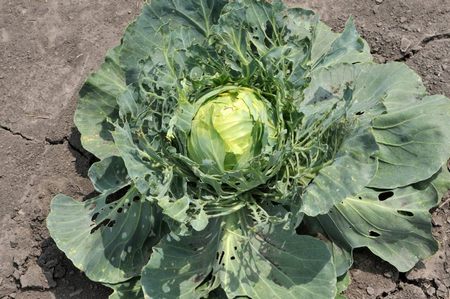
The main damage is caused to cabbage, but the pest regales itself with others: horseradish, turnip, radish, etc.
In addition to the harmful effects on vegetation, the larvae create other troubles. So, they secrete special substances that provoke irritation of human skin. For birds, the white caterpillar is also dangerous; when it is used, birds often die.
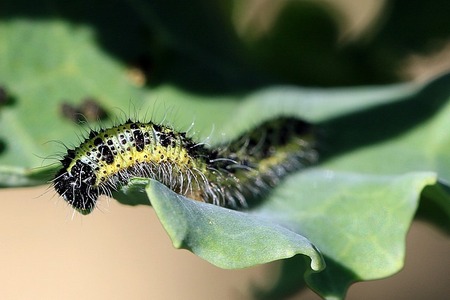
Caterpillar of bright yellow color, 4 cm long, with 16 legs, live for several weeks
Ways to protect the garden from pests
An adult can live for 1-1.5 months, during which time the female lays a large number of eggs. You can try to prevent the emergence of new generations of insects. To do this, a number of measures should be taken:
Agricultural methods
Assume the need to remove cruciferous weeds. Favorite food of the cabbage white butterfly: colza, shepherd's purse. You need to clear a large area: the entire plot, the garden, since even a small amount of weeds of these species will help attract butterflies.
Here's the best way to scare off a butterfly pest - sow dill after weeding. It grows quickly, does not shade the vegetables and spreads the desired flavor.
Mechanical removal
In this case, you need to independently collect the larvae, examining the leaves of plants from two sides. The task is laborious, but you can try to influence the breeding process by destroying the butterfly pupae. Identification features: yellow-green color, with dark patches.
Pupae are fixed on fences, under the roof, in the crevices of old stumps, trees, on the branches of shrubs. In the spring, all buildings and trees are inspected. It is recommended to wash the probable attachment points of the pupae with a powerful jet of water from a hose. Completely destroy insects in this way will not work, but you can greatly reduce their numbers.
Chemical
Chemicals: Karate, Fufanon, Aliot, Proclaim, Borey, Iskra, Alatar, Herold and the like. For the destruction of cabbage, means based on insecticides of different classes are suitable: neonicotinoids, pyrethroids, organophosphorus compounds.
Biologicals
Not as harmful as chemicals, so they are used more often. The main options: Lepidocid, Fitoverm, Bitoxibacillin.
Preparations based on chemistry, as well as biological pesticides, are recommended to be sprayed during the growing season.
As an additional measure, whitewashing of tree trunks is used. The favorite food of cabbage (radish, cabbage, radish, turnip, etc.) is planted at some distance from each other. Marigolds, garlic, dill, valerian, parsley, carrots and lemon balm will help scare away the insect.
Watch video: How to protect cabbage from cabbage butterflies
How to influence the pest?
- Traps are prepared: a viscous solution of yeast. Containers with such a liquid are installed near cruciferous plants.
- Spraying with a solution of valerian: 1 bottle / 3 liters of water.
- Another recipe for spraying plantations: ash (1/2 l), a bucket of hot water. Let the solution stand, then remove the sediment and apply by adding 2 tbsp. l. softened soap.
- Prepare a mixture of wormwood, yarrow and burdock. Mix raw materials and hot water in a ratio of 1:3. The remedy is insisted for 2-3 days, then filtered.
In the garden, natural enemies of cabbage appear - riders. Their eggs should not be destroyed, and offspring can be found on the inside of the leaves, in the same place where the white butterfly lays its eggs. In addition, it is recommended to cover the plants with a mosquito net. This measure will not allow pests to fly close to the plantations.
Thus, when planning the planting of cabbage, care must be taken to protect the crops. The main enemy is cabbage. Finding out how many butterflies live, as well as studying their lifestyle, you can choose safe methods of dealing with them. So, in the spring you need to destroy the pupae of these insects. If butterflies nevertheless appeared, it is necessary to spray the plants with special means, additionally protecting them with a net.
Similar articles




